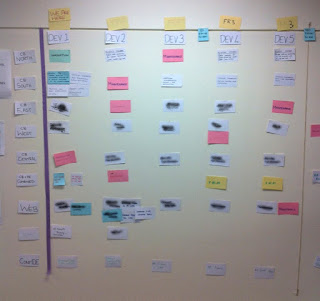These are my Top Tips for performing Planning Poker in an efficient, effective and fun manner.
Bring Reference Stories
Bring a range of Reference User Stories on index cards to your estimation session. I find that a range of sizes and types of work helps immensely when we are sizing. I recommend that you have between 3 to 10 Reference Stories, in the size range of 1 Story Points to 8 or even 13 Story Points. The reference story index cards can just have the story title written on them (provided the team is well aware of what the story entails).Bringing these reference stories serves two purposes. 1. There is no need to recall the Reference Stories from memory, they are right there in front of you. This makes the process of sizing stories easier and faster. 2. It stops ‘size creep’ / ‘story point inflation’, which unintentionally affects some teams.
Involve Everyone
Everyone should display an estimate each round. We do not want the situation where Developers put out a ‘?’ card each time there is a testing focused story and vis-versa.But how can Testers size Development work you ask? By using Relative Estimation along with asking some probing questions, is the answer. The questions that we need to train the team members to ask, highlight the differences of the Un-sized Story to the Reference Stories.
Some sample probing questions:
- Testers can ask: How many components does it affect? How many components were affected in the reference story?
- Testers can ask: How much development work is there per component, compared to this reference story?
- Developers can ask: Do we need to test it on multiple platforms, like we did for this reference story?
- Developers can ask: Are there more functional areas to tests than this reference story?
With this information out on the table, everyone should have enough information to compare the Un-sized Story to the Reference Stories and hence select a Relative Estimate. This is one the key reasons that Planning Poker works in a cross functional team.
Talk about Complexity, Effort & Doubt
Story Points are made up of complexity, effort,& doubt, with Complexity being the most important aspect. Everyone in the team needs to understands what these all mean and how it relates to their work.Talk about:
- More/less complexity (more interactions between components, technical debt that makes it harder to make changes, difficult algorithms, availability of assistance from an expert in the area, availability of documentation that explains how it all works, etc.)
- More/less effort (extra tasks, extra components to work on, less test cases to create, ability to reuse existing work, available of a tool that automates part of the work, etc.)
- More/less doubt (lack of tests, uncertainty regarding the current design, unclear expectations from the Product Owner, new technology, not sure if the documentation covers it, etc.)
Don’t talk about numbers
Don’t let team members talk about changing your estimate. E.g. 'I will go down to a 5.' 'Ok, ok it's a 2.', ‘Alright I’ll go up’.This results in or is the result of peer pressure. ‘Story Points are only one third of the reason for estimating’, peer pressure prevents the team from gaining the other two thirds worth of benefits.
Also try to avoid talking about how much time it will take to do things. ‘Story Points do not equate to Time’, so we should minimise our mention of time.
Instead of talking about numbers, get the team to focus on Effort, Complexity & Doubt, and then re-vote.
Choose the Majority answer
Create a team rule that ‘When there is a lack of consistency in estimates after two rounds of estimation; the estimate which the majority of team members have chosen is selected as the estimate.’Picking the majority answer instead of picking the highest answer (or the lowest) ensures that the team’s estimates will average out over the long term. Always picking the highest estimate will inflate the team’s estimates, and lead to less predictability.
 |
| In the above example, with 4 votes to 3 votes, the team would choose 5 as their estimate. |
Use estimation to confirm shared understanding
Watch out for stalled/circular discussions and call for the team to estimate.Sometimes you will find that the team all throws out the same estimate! When they do you can move on. Even though the conversation was going around in circles the team had a similar idea of the size of the work. Which means you can sort out the details in the sprint, instead of trying to sort it out in your estimation session.
If some team members do throw out different estimates; then you need to head back to the discussion to try and clear it up. The good news is that the attempt at sizing will have only taken a minute or so.
Combined result
Once you and your team are practiced in how to run an effective Planning Poker session; it should be fast, accurate and fun.Do you have any other tips that have lead your team towards great Planning Poker sessions?
Interested in more tips?
Interested in estimation?
- Fast Estimation
- Story Points are only one third of the reason to estimate
- Story Points do not equate to time
Training available in South East QLD, Australia
If this article was interesting to you, then your team would
likely benefit from face to face training on Agile Estimation. I run a one-hour
Agile Estimation training session, that is highly interactive, immensely fun
and teaches the foundation of agile estimation along with how to effectively
run Planning Poker as well as Fast Estimation. Please contact me to set up a
training session for your team: andrewrusling@hotmail.com












